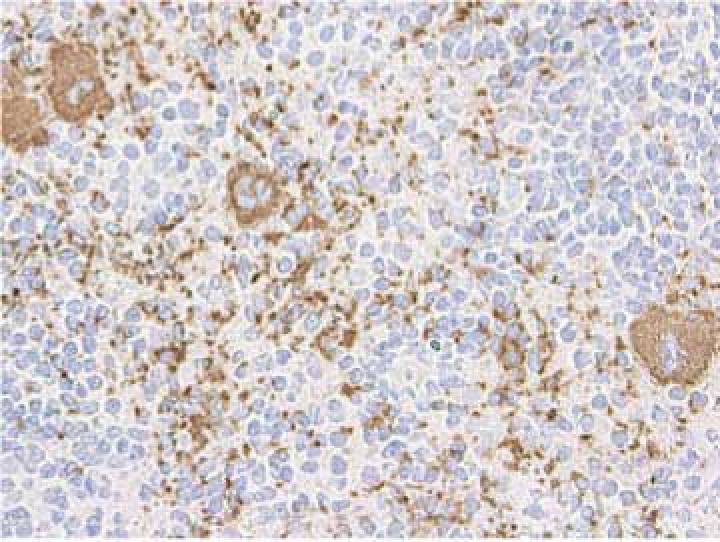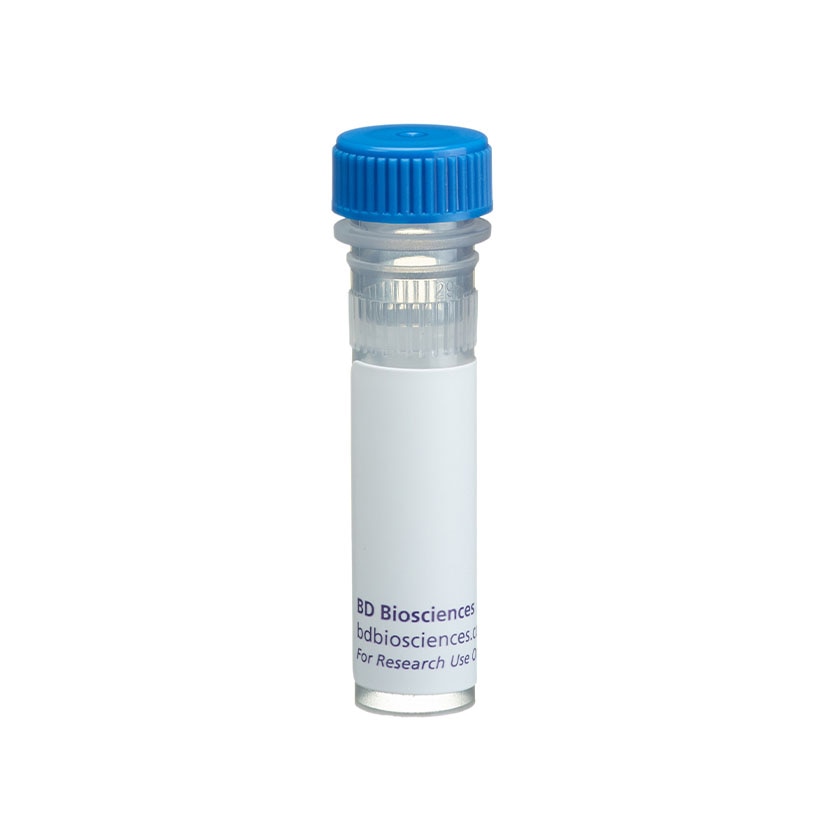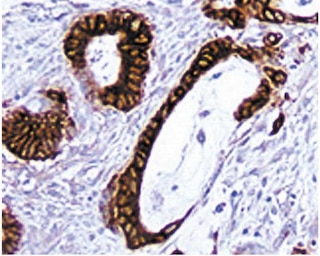-
Your selected country is
Middle East / Africa
- Change country/language
Old Browser
This page has been recently translated and is available in French now.
Looks like you're visiting us from {countryName}.
Would you like to stay on the current country site or be switched to your country?




Immunohistochemical staining of CD61 positive cells. Frozen sections of normal mouse spleen were reacted with the anti-CD61 antibody. Cells positive for CD61 can be identified by the brown labeling of their cell membranes. Amplification 20X.


BD Pharmingen™ Purified Hamster Anti-Mouse CD61

Regulatory Status Legend
Any use of products other than the permitted use without the express written authorization of Becton, Dickinson and Company is strictly prohibited.
Preparation And Storage
Recommended Assay Procedures
Immunohistochemistry: The 2C9.G2 antibody specific for mouse CD61 is recommended to test for immunohistochemical staining of acetone-fixed frozen sections. Tissues tested were mouse spleen and thymus. The antibody stains platelets activated T lymphocytes and polymorphonuclear granulocytes. The isotype control recommended for use with this antibody is purified hamster IgG (Cat. No. 550344). For optimal indirect immunohistochemical staining, the 2C9.G2 antibody should be titrated (1-10 to 1-50 dilution and visualized via a three-step staining procedure in combination with anti-hamster IgG cocktail (Cat. No. 550335) as the secondary antibody and Streptavidin-HRP (Cat. No. 550946) together with the DAB detection system (Cat. No. 550880).
A detailed protocol of the immunohistochemical procedure is available at our website, http://www.bdbiosciences.com/support/resources
Product Notices
- Since applications vary, each investigator should titrate the reagent to obtain optimal results.
- Caution: Sodium azide yields highly toxic hydrazoic acid under acidic conditions. Dilute azide compounds in running water before discarding to avoid accumulation of potentially explosive deposits in plumbing.
- Source of all serum proteins is from USDA inspected abattoirs located in the United States.
- Although hamster immunoglobulin isotypes have not been well defined, BD Biosciences Pharmingen has grouped Armenian and Syrian hamster IgG monoclonal antibodies according to their reactivity with a panel of mouse anti-hamster IgG mAbs. A table of the hamster IgG groups, Reactivity of Mouse Anti-Hamster Ig mAbs, may be viewed at http://www.bdbiosciences.com/documents/hamster_chart_11x17.pdf.
- An isotype control should be used at the same concentration as the antibody of interest.
- This antibody has been developed for the immunohistochemistry application. However, a routine immunohistochemistry test is not performed on every lot. Researchers are encouraged to titrate the reagent for optimal performance.
- Please refer to www.bdbiosciences.com/us/s/resources for technical protocols.
Companion Products





The 2C9.G2 monoclonal antibody specifically binds to the integrin β3 chain (CD61), which associates with the integrin αv chain (CD51) to form the vitronectin receptor, as well as the αIIb chain (CD41) to form the gpIIb/IIIa complex. Both receptors mediate adhesion to fibronectin, fibrinogen, vitronectin, thrombospondin, and von Willebrand factor. Leukocyte-endothelial adhesion is also mediated by the binding of αvβ3 integrin or vitronectin receptor to CD31 (PECAM-1). In addition, interaction of the αvβ3 integrin with its ligands regulates the L-type Ca2+ channel in vascular smooth muscle cells, possibly mediating vasodilatory responses to injury. Soluble and insoluble 2C9.G2 mAb mimics the effect of the natural ligands in smooth muscle cells from rat cremaster arterioles. Furthermore, osteopontin, also named Eta-1, is a cytokine that binds to αvβ3. CD61 is expressed on platelets, activated T lymphocytes, polymorphonuclear granulocytes, and blastocysts. Cross-reactivity of mAb 2C9.G2 to rat mast cells and platelets has been observed by flow cytometric analysis. mAb 2C9.G2 has been demonstrated to block binding of rat and mouse cells to fibronectin.
Development References (8)
-
Ashkar S, Weber GF, Panoutsakopoulou V, et al. Eta-1 (osteopontin): an early component of type-1 (cell-mediated) immunity. Science. 2000; 287(5454):860-864. (Clone-specific: Blocking). View Reference
-
Frieser M, Hallmann R, Johansson S, Vestweber D, Goodman SL, Sorokin L. Mouse polymorphonuclear granulocyte binding to extracellular matrix molecules involves beta 1 integrins. Eur J Immunol. 1996; 26(12):3127-3136. (Biology). View Reference
-
Kieffer N, Phillips DR. Platelet membrane glycoproteins: functions in cellular interactions. Annu Rev Cell Biol. 1990; 6:329-357. (Biology). View Reference
-
Moulder K, Roberts K, Shevach EM, Coligan JE. The mouse vitronectin receptor is a T cell activation antigen. J Exp Med. 1991; 173(2):343-347. (Biology). View Reference
-
Piali L, Hammel P, Uherek C, et al. CD31/PECAM-1 is a ligand for alpha v beta 3 integrin involved in adhesion of leukocytes to endothelium. J Cell Biol. 1995; 130(2):451-460. (Clone-specific: Blocking). View Reference
-
Schultz JF, Armant DR. Beta 1- and beta 3-class integrins mediate fibronectin binding activity at the surface of developing mouse peri-implantation blastocysts. Regulation by ligand-induced mobilization of stored receptor. J Biol Chem. 1995; 270(19):11522-11531. (Clone-specific: Blocking). View Reference
-
Wu X, Mogford JE, Platts SH, Davis GE, Meininger GA, Davis MJ . Modulation of calcium current in arteriolar smooth muscle by alphav beta3 and alpha5 beta1 integrin ligands. J Cell Biol. 1998; 143(1):241-252. (Biology). View Reference
-
Yasuda M, Hasunuma Y, Adachi H, et al. Expression and function of fibronectin binding integrins on rat mast cells.. Int Immunol. 1995; 7(2):251-8. (Clone-specific: Blocking). View Reference
Please refer to Support Documents for Quality Certificates
Global - Refer to manufacturer's instructions for use and related User Manuals and Technical data sheets before using this products as described
Comparisons, where applicable, are made against older BD Technology, manual methods or are general performance claims. Comparisons are not made against non-BD technologies, unless otherwise noted.
For Research Use Only. Not for use in diagnostic or therapeutic procedures.
Report a Site Issue
This form is intended to help us improve our website experience. For other support, please visit our Contact Us page.